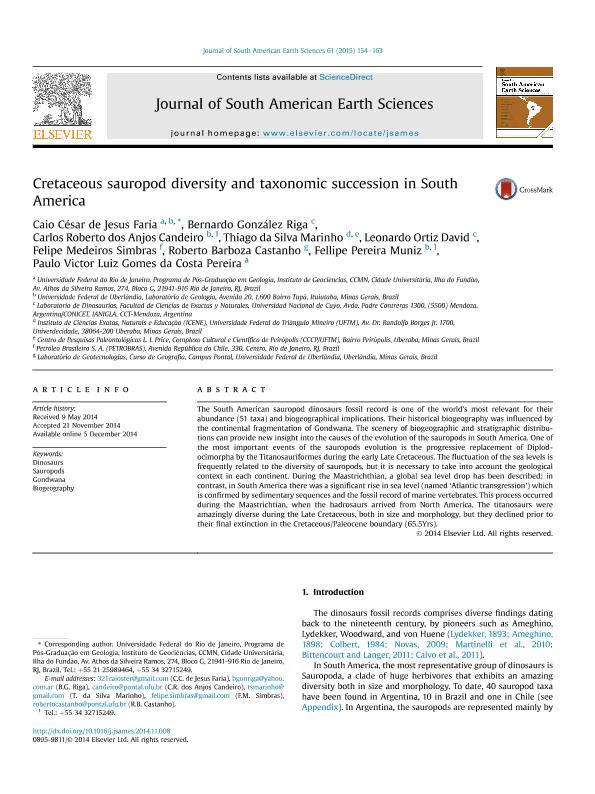Artículo
Cretaceous sauropod diversity and taxonomic succession in South America
de Jesus Faria, Caio Cesar; Gonzalez Riga, Bernardo Javier ; dos Anjos Candeiro, Carlos Roberto; da Silva Marinho, Thiago; Ortiz David, Leonardo Daniel
; dos Anjos Candeiro, Carlos Roberto; da Silva Marinho, Thiago; Ortiz David, Leonardo Daniel ; Medeiros Simbras, Felipe; Barboza Castanho, Roberto; Pereira Muniz, Fellipe; Gomes da Costa Pereira, Paulo Victor Luiz
; Medeiros Simbras, Felipe; Barboza Castanho, Roberto; Pereira Muniz, Fellipe; Gomes da Costa Pereira, Paulo Victor Luiz
 ; dos Anjos Candeiro, Carlos Roberto; da Silva Marinho, Thiago; Ortiz David, Leonardo Daniel
; dos Anjos Candeiro, Carlos Roberto; da Silva Marinho, Thiago; Ortiz David, Leonardo Daniel ; Medeiros Simbras, Felipe; Barboza Castanho, Roberto; Pereira Muniz, Fellipe; Gomes da Costa Pereira, Paulo Victor Luiz
; Medeiros Simbras, Felipe; Barboza Castanho, Roberto; Pereira Muniz, Fellipe; Gomes da Costa Pereira, Paulo Victor Luiz
Fecha de publicación:
08/2015
Editorial:
Pergamon-Elsevier Science Ltd
Revista:
Journal of South American Earth Sciences
ISSN:
0895-9811
Idioma:
Inglés
Tipo de recurso:
Artículo publicado
Clasificación temática:
Resumen
The South American sauropod dinosaurs fossil record is one of the world's most relevant for their abundance (51 taxa) and biogeographical implications. Their historical biogeography was influenced by the continental fragmentation of Gondwana. The scenery of biogeographic and stratigraphic distributions can provide new insight into the causes of the evolution of the sauropods in South America. One of the most important events of the sauropods evolution is the progressive replacement of Diplodocimorpha by the Titanosauriformes during the early Late Cretaceous. The fluctuation of the sea levels is frequently related to the diversity of sauropods, but it is necessary to take into account the geological context in each continent. During the Maastrichthian, a global sea level drop has been described; in contrast, in South America there was a significant rise in sea level (named 'Atlantic transgression') which is confirmed by sedimentary sequences and the fossil record of marine vertebrates. This process occurred during the Maastrichtian, when the hadrosaurs arrived from North America. The titanosaurs were amazingly diverse during the Late Cretaceous, both in size and morphology, but they declined prior to their final extinction in the Cretaceous/Paleocene boundary (65.5Yrs).
Palabras clave:
Biogeography
,
Dinosaurs
,
Gondwana
,
Sauropods
Archivos asociados
Licencia
Identificadores
Colecciones
Articulos(IANIGLA)
Articulos de INST. ARG. DE NIVOLOGIA, GLACIOLOGIA Y CS. AMBIENT
Articulos de INST. ARG. DE NIVOLOGIA, GLACIOLOGIA Y CS. AMBIENT
Citación
de Jesus Faria, Caio Cesar; Gonzalez Riga, Bernardo Javier; dos Anjos Candeiro, Carlos Roberto; da Silva Marinho, Thiago; Ortiz David, Leonardo Daniel; et al.; Cretaceous sauropod diversity and taxonomic succession in South America; Pergamon-Elsevier Science Ltd; Journal of South American Earth Sciences; 61; 8-2015; 154-163
Compartir
Altmétricas



